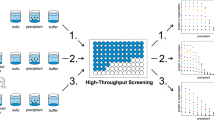Abstract
An IgG1 monoclonal antibody (MAB) was isolated from hybridoma culture supernatant by affinity precipitation with an Eudragit S-100-based heterobifunctional ligand. Affinity binding was performed in a homogeneous aqueous phase at pH 7.5 followed by precipitation of the bound affinity complex by lowering the pH to 4.8. After two washing steps, elution of specifically bound MAB was achieved by incubating the precipitate with 0.1 M glycine.HCl pH 2.5. The influence of elution volume and time on the recovery of active MAB and the overall purification factor were studied. The best conditions enabled the recovery of 50.2% of active MAB with a purification factor of 6.2. A further dialysis against 50 mM Tris.HCl pH 8.0 increased the activity yield and the purification factor to 68.4% and 8.3, respectively. This result showed that part of the antibody activity loss during affinity precipitation was due to a reversible inactivation process, being easily recovered after a refining dialysis step.
Similar content being viewed by others
References
Bradshaw AP and Sturgeon RJ (1990) The synthesis of soluble polymer-ligand complexes for affinity precipitation studies. Biotechnol. Tech. 4: 67–71.
Chen J-P (1990) Novel affinity-based processes for protein purification. J. Ferment. Bioeng. 70: 199–209.
Daniak MB, Izumrudov VA, Muronetz VI, Galaev I and Mattiasson B (1998–99). Affinity precipitation of monoclonal antibodies by nonstoichiometric polyelectrolyte complexes. Bioseparation 7: 231–240.
Galaev I and Mattiasson B (1999) 'smart’ polymers and what they could do in biotechnology and medicine. Trends Biotechnol. 17: 335–340.
Goding JW (1986) Monoclonal Antibodies — Principles and Practice, Academic Press, London, UK.
Guoqiang D, Batra R, Kaul RH, Gupta MN and Mattiasson B (1995) Alternative modes of precipitation of Eudragit S-100: a potential ligand carrier for affinity precipitation of protein. Bioseparation 5: 339–350.
Guoqiang D, Lali A, Kaul RH and Mattiasson B (1994) Affinity thermoprecipitation of lactate dehydrogenase and pyruvate kinase from porcine muscle using Eudragit bound Cibacron blue. J. Biotechnol. 37: 23–31.
Gupta MN, Kaul RH, Dissing U and Mattiasson B (1996) Affinity precipitation of proteins. J. Mol. Recognit. 9: 356–359.
Hill CR, Thompson LG and Kenney AC (1989) Immunopurification. In: Harris ELV & Angal S (eds.) Protein Purification Methods — A Practical Approach, (pp. 282–292) IRL Press, Oxford, UK.
Irwin JA and Tipton KF (1995) Affinity precipitation: a novel approach to protein purification. Essays Biochem. 29: 137–157.
Kamihira M, Iijima S and Kobayashi T (1992a) Stabilities of antigen and antibody under elution conditions in immunoaffinity chromatography using monoclonal antibody. Bioseparation 3: 185–188.
Kamihira M, Kaul R and Mattiasson B (1992b) Purification of recombinant protein A by aqueous two-phase extraction and affinity precipitation for the purification of lactate dehydrogenase. Biotechnol. Bioeng. 40: 1381–1387.
Kaul RH and Mattiasson B (1992) Secondary purification. Bioseparation 3: 1–26.
Kondo A, Kaneko T and Higashitani K (1994) Development and application of thermo-sensitive immunomicrospheres for antibody purification. Biotechnol. Bioeng. 44: 1–6.
Linné-Larsson E and Mattiasson B (1994) Isolation of concanavalin A by affinity precipitation. Biotechnol. Tech. 8: 51–56.
Linné-Larsson E, Galaev IY, Lindahl L and Mattiasson B (1996) Affinity precipitation of Concanavalin A with p-aminophenyl-α-D-glucopyranoside modified Eudragit S-100. Bioseparation 6: 273–282.
Lowe CR, Burton SJ, Burton NP, Alderton WK, Pitts JM and Thomas JA (1992) Designer dyes. Biomimetic ligands for the purification of pharmaceutical proteins by affinity chromatography. Trends Biotechnol. 10, 442–448.
Mattiasson B, Kumar A and Galaev I (1998) Affinity precipitation of proteins: design criteria for an efficient polymer. J. Mol. Recognit. 11: 211–216.
Powers D, Carbonell R and Kilpatrick PK (1994) Affinity precipitation of antibody by ligand-modified phospholipids. Biotechnol. Bioeng. 44: 509–522.
Sadana A and Beelaram AM (1994) Protein inactivations during novel bioseparation techniques. Bioseparation 4: 39–61.
Shu H-C, Guoqiang D, Kaul RH and Mattiasson B (1994) Purification of the D-lactate dehydrogenase from Leuconostoc mesenteroides ssp. cremoris using a sequential precipitation procedure. J. Biotechnol. 34: 1–11.
Taipa MA, Kaul RH, Mattiasson B and Cabral JMS (1998) Preliminary studies on the purification of a monoclonal antibody by affinity precipitation. J. Mol. Recognit. 11: 240–242.
Taipa MA, Liebeton K, Costa JV, Cabral JMS and Jäeger K-E (1995) Lipase from Chromobacterium viscosum: biochemical characterization indicating homology to lipase from Pseudomonas glumae. Biochim. Biophys. Acta 1256: 396–402.
Taniguchi M, Kobayashi M and Fujii M (1989a) Properties of a reversible soluble-insoluble cellulase and its application to repeated hydrolysis of crystaline cellulose. Biotechnol. Bioeng. 34: 1092–1097.
Taniguchi M, Kobayashi M, Natsui K and Fujii M (1989b) Purification of staphylococcal protein A by affinity precipitation using a reversibly insoluble polymer with human IgG as a ligand. J. Ferment. Bioeng. 68: 32–36.
Yarmush ML, Antonsen KP, Sundaram S and Yarmush DM (1992) Immunoadsorption: strategies for antigen elution and production of reusable adsorbents. Biotechnol. Prog. 8: 168–176.
Author information
Authors and Affiliations
Rights and permissions
About this article
Cite this article
Ângela Taipa, M., Kaul, RH., Mattiasson, B. et al. Recovery of a monoclonal antibody from hybridoma culture supernatant by affinity precipitation with Eudragit S-100. Bioseparation 9, 291–298 (2000). https://doi.org/10.1023/A:1011183904966
Issue Date:
DOI: https://doi.org/10.1023/A:1011183904966




